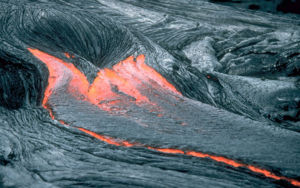Lava
 From Conservapedia
From Conservapedia 
Lava is the term for magma from the Earth's mantle when it erupts onto the Earth's surface. Lava differs from magma in that it contains less dissolved gases, due to the decreased pressure at the surface. Geologists also use the word to describe the solidified deposits of lava flows and fragments hurled into the air by explosive eruptions (for example, lava bombs or blocks).
Lavas differ in chemical composition, but most forms of lava average 3000-4000 degrees Fahrenheit. Lavas are classified into the following categories based on their chemical composition: Basalt (Hawaiian volcanoes), Andesite (Andes Mountains), Dacite (Mt. St. Helens), or Rhyolite (Yellowstone caldera). Lava flow is classified into two types: pahoehoe, which has low viscosity and moves quickly in roping patterns, and aa, which moves slowly by crumbling over itself.
A person can generally get as close as 1.5 metres to a lava flow before his clothes ignite.
Categories: [Igneous Rocks]
↧ Download as ZWI file | Last modified: 03/02/2023 06:45:06 | 53 views
☰ Source: https://www.conservapedia.com/Lava | License: CC BY-SA 3.0
 ZWI signed:
ZWI signed: KSF
KSF